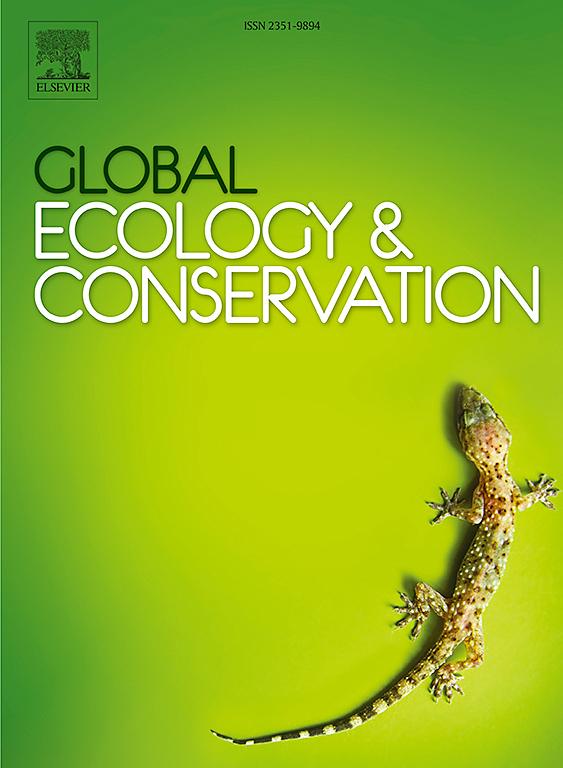入侵麝香鼠和湿地间隙对北美麝香鼠数量下降的影响
IF 3.4
2区 环境科学与生态学
Q1 BIODIVERSITY CONSERVATION
引用次数: 0
摘要
北美的麝鼠(Ondatra zibethicus)数量正在下降。造成数量下降的确切原因目前尚不清楚。与此类似,整个北美大陆的湿地也经历了香蒲(Typha)的入侵。具体来说,T. x glauca 是本地 T. latifolia 与非本地 T. angustifolia 的杂交种,其分布范围和数量都在增加。这种杂交种对湿地生态系统造成了许多负面影响,包括生物多样性、开放水域栖息地以及水与新生植被的交错减少,而后者是麝鼠的重要栖息地特征。我们试图确定入侵的 T. x glauca 对麝鼠种群的影响。我们对加拿大安大略省南部 39 个以 Typha 为主的沼泽地进行了取样,以验证麝鼠在北美数量减少的假设,其原因是(x glauca 的相对丰度增加,以及 (2) 与 T. x glauca 入侵相关的湿地交错减少。我们利用家鼠计数估算了麝鼠的种群密度,对 Typha 群落进行了采样以确定 T. x glauca 的相对丰度,并利用遥感技术测量了湿地间距。我们发现,麝鼠种群密度与间距呈正相关,但与 T. x glauca 的相对丰度无关。然而,大多数地点的麝鼠高度以 T. x glauca 为主,这限制了我们的推论。我们的研究结果表明,湿地结构的变化可能是北美麝鼠种群数量下降的原因之一,但要确定T.本文章由计算机程序翻译,如有差异,请以英文原文为准。
Impact of invasive Typha and wetland interspersion on muskrat declines in North America
Muskrat (Ondatra zibethicus) populations are declining in North America. The exact cause of these declines is largely unknown. Along a similar timeframe, wetlands have been experiencing an invasion of cattail (Typha) throughout the continent. Specifically, T. x glauca, a hybrid of native T. latifolia and non-native T. angustifolia, has been increasing in range and abundance. This hybrid is associated with many negative impacts on wetland ecosystems, including reductions in biodiversity, open water habitat, and interspersion of water and emergent vegetation, the latter of which is an important habitat feature for muskrats. We sought to determine the impact of invasive T. x glauca on muskrat populations. We sampled 39 Typha-dominated marshes in southern Ontario, Canada to test the hypotheses that muskrats are declining in North America due to: (1) the increased relative abundance of T. x glauca in marshes, and (2) reduced wetland interspersion, which is associated with T. x glauca invasions. We estimated muskrat population density using house counts, sampled Typha communities to determine the relative abundance of T. x glauca, and measured interspersion using remote sensing techniques. We found that muskrat population density was positively associated with interspersion, but not associated with the relative abundance of T. x glauca. However, most sites were highly dominated by T. x glauca, limiting our inference. Our findings suggest that changing wetland structure may be contributing to muskrat population declines in North America, but more research is needed to determine the full impact of T. x glauca invasions on muskrat population declines.
求助全文
通过发布文献求助,成功后即可免费获取论文全文。
去求助
来源期刊

Global Ecology and Conservation
Agricultural and Biological Sciences-Ecology, Evolution, Behavior and Systematics
CiteScore
8.10
自引率
5.00%
发文量
346
审稿时长
83 days
期刊介绍:
Global Ecology and Conservation is a peer-reviewed, open-access journal covering all sub-disciplines of ecological and conservation science: from theory to practice, from molecules to ecosystems, from regional to global. The fields covered include: organismal, population, community, and ecosystem ecology; physiological, evolutionary, and behavioral ecology; and conservation science.
 求助内容:
求助内容: 应助结果提醒方式:
应助结果提醒方式:


